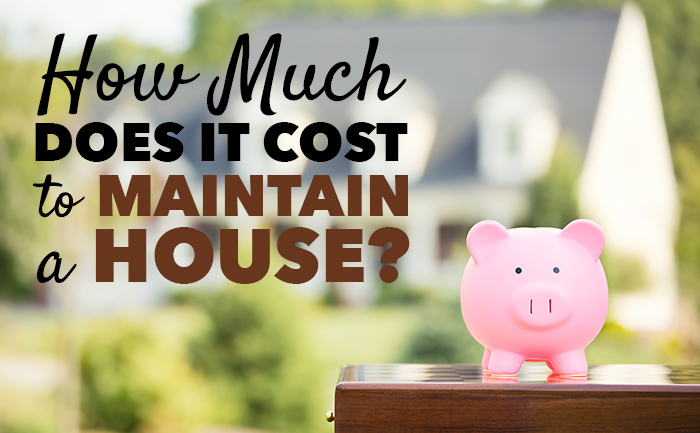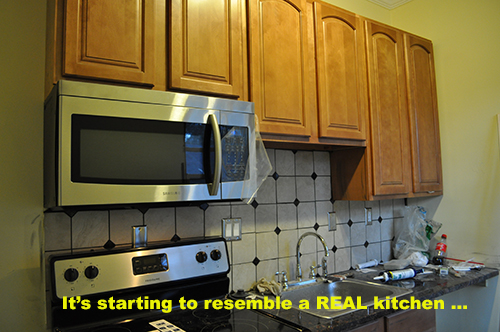
When we first purchased a house, we thought the only expense would be the mortgage. Haha!
Little did we realize that the mortgage is only the beginning.
Homeowners pay for an absurd amount of operations, maintenance and repairs:
Trash service. Water and sewer bills. Gutter cleaning. Termite treatment. Pest control. Power-washing. Replacing the siding, windows, roof, fascia, rotted joists, appliances, floorboards, drywall holes. HVAC tune-ups. Reinforcing a crumbling foundation.
The list goes on …
How can you estimate home repair costs? Read on.
What’s in a Mortgage?
First, let’s start with the obvious expense that leaps to everyone’s mind: the mortgage.
Your mortgage payment consists of four elements:
- Principal (Your Equity/Ownership)
- Interest
- Property Taxes
- Homeowner’s Insurance
Together, these are called “PITI” (Principal, Interest, Taxes, Insurance), which leads to the obvious joke: “Homeowner? What a pity!!”
How much will this cost? As of January 2015, the national average interest rate is 3.63 percent on a 30-year fixed loan for borrowers with good credit. If you’re cash-out refinancing a home, add one to two percent to the standard mortgage rate. If you’re putting less than 20 percent down (which I don’t recommend, unless you’re getting a screamin’ deal), you’ll also need to fork over private mortgage insurance, or PMI.
Insurance
As a general rule-of-thumb, homeowners insurance costs $4 per every $1,000 in home value, per year. (Or $400 per every $100,000 in home value.)
For example:
House: $200,000
Divided by 1000 = 200
Multiplied by $4 = $800
Homeowner’s insurance on this $200,000 house would cost $800 per year, which divides out to $67 per month.
Again, that’s a broad rule-of-thumb, so give yourself “wiggle room.” Remember: rental properties carry higher insurance premiums.
If your rental property is vacant, you’ll need “vacancy insurance,” which is more expensive than regular insurance. (We pay an additional $70 per month, on top of our regular homeowners insurance, for vacancy protection on a rental property that’s only worth $50,000.)
Water
When it comes to utilities, you control your destiny (within limits).
When we purchased our three-unit apartment building (triplex), the water bills regularly came to $350/month, or $120/month per apartment. Ouch!
So we embarked on an all-out Water Bill Offensive. We installed low-flow toilets, low-flow shower heads, and low-flow faucets coupled with additional aerators. We even redesigned the yard to minimize water usage. Eventually, we wrestled the water bill down to $120/month — only $40 per month per apartment. Hooray!
The moral of the story: You can chop (some) of your costs by more than half — but it’ll take focused effort in the beginning.
Trash
This rate will vary based on your city. We own 5 houses in Georgia, and pay around $33/month for every single-family home.
My triplex costs $100/mo for trash ($33 per unit * 3 units), because the City of Atlanta regards each unit as a separate home. Not all cities insist on charging multi-unit houses as “separate” houses, so research the policies of your particular city. If you have more than 4-5 units in a single building, it’s often cheaper to just forgo the city trash services and rent a dumpster through a private company (assuming your city allows this.)
Repairs and Maintenance
Here’s one of the BEST rules-of-thumb I’ve ever heard: Repairs and maintenance will cost one percent of the purchase price per year. In other words, for every $100,000 worth of house, you’ll spend $1,000 per year on maintenance.
“WTF? That sounds way too high.”
Au contraire, my friend.
- Basic vinyl windows cost $250, including installation, permits and haul-off, and need replacement every 30 years. If your home has 20 windows, they cost $166 per year.
- An asphalt-shingle roof on a 1,500-square-foot house will cost around $10,000 and needs to be replaced every 25 years. Your roof costs $400 per year.
- Carpet, padding, installation, haul-away and disposal costs $15 per square yard and needs replacement every 8 years. If your home needs 100 square yards of carpeting, this costs $187.50 per year.
Apply this to everything: Water heater. HVAC. Gutters. Siding. Paint. Plumbing. Toilets. Shower valves. Countertops. Cabinets. Sink basins. Floor tile. Porches and decks. Appliances. Smoke alarms. Even outlet covers (yes, little things add up, especially when labor costs are involved).
We’re not done yet.
Those are replacement costs, but each year, you’ll have maintenance costs, as well. Your carpets need deep-cleaning. Your air-vents need professional suctioning. Your pressure-treated deck needs another coat of stain. You need to shell out for pest control, termite treatments, gutter cleaning, lawn aerating, re-sodding, mulching, weeding, re-sealing the grout around your tub.
Scared yet?
Don’t worry. This is where a “Home Repair Fund” comes into play.
Open a special savings account that’s earmarked specifically for home repairs and maintenance.
Many people don’t like the idea of cash “sitting” in their savings account, earning a return that’s so low it can’t even keep pace with inflation. I’d rather forgo some returns so that I can sleep at night. The water heater can burst at 2 a.m., or the dishwasher can overflow, ruining the carpet, or any number of other things can go wrong. When that happens, I like knowing that I can write a check to cover the bill, without breaking a sweat.
Property Management
This tip applies only to rental properties, of course.
Management usually costs 100 percent of the first month’s rent (for each new tenant), followed by an ongoing 8 to 10 percent fee. In addition, managers may charge extra fees for eviction proceedings, nuisance inspections and other additional work.
Sure, you can manage it yourself — but this takes time, and time is money. If you manage it yourself, you should pay yourself. You can’t pay yourself $0 and pretend your “profits” are higher — that’s B.S. accounting. “Make a profit AFTER paying yourself.” (That way, you can remove yourself from the equation and the numbers will stay the same.)
How to Track Your Expenses
Okay, we’ve talked about the expenses. But how can you keep track of all of this? Are you going to have a closet that’s overflowing with receipts?
Nope. Here’s a ridiculously simple way to track your rental expenses: (1) Open a separate bank account that’s only for rental property income and expenses. (2) Open a small business card, and set it up to automatically pay-in-full every month from your business bank account. Get one that offers either cashback or airline miles, so that you can fund your next vacation from the bills you need to pay anyway. (3) Make sure that all your rent payments get deposited in this account — never in your personal account. (4) Make sure that all rental expenses get paid from this credit card — never from your personal card. (5) Link both accounts to bookkeeping software.
And that’s it! Tracking expenses is mostly automatic, as long as you set up the right systems at the beginning.
